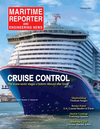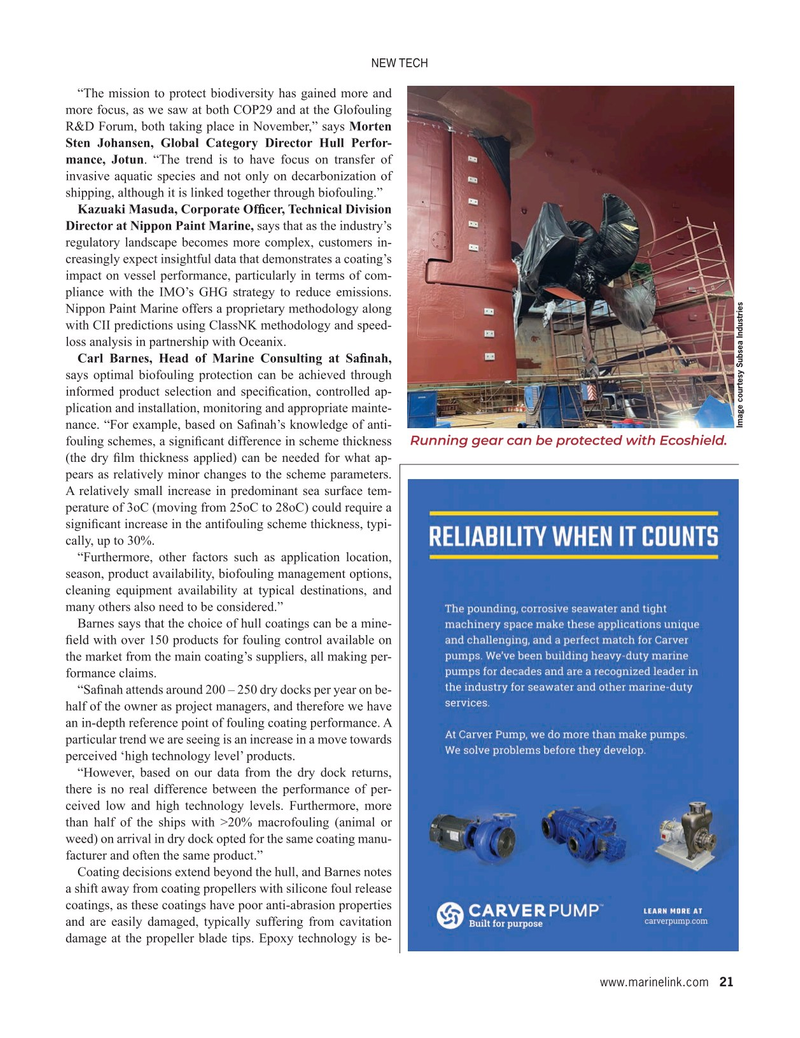
Page 21: of Maritime Reporter Magazine (February 2025)
Read this page in Pdf, Flash or Html5 edition of February 2025 Maritime Reporter Magazine
NEW TECH “The mission to protect biodiversity has gained more and more focus, as we saw at both COP29 and at the Glofouling
R&D Forum, both taking place in November,” says Morten
Sten Johansen, Global Category Director Hull Perfor- mance, Jotun. “The trend is to have focus on transfer of invasive aquatic species and not only on decarbonization of shipping, although it is linked together through biofouling.”
Kazuaki Masuda, Corporate Of? cer, Technical Division
Director at Nippon Paint Marine, says that as the industry’s regulatory landscape becomes more complex, customers in- creasingly expect insightful data that demonstrates a coating’s impact on vessel performance, particularly in terms of com- pliance with the IMO’s GHG strategy to reduce emissions.
Nippon Paint Marine offers a proprietary methodology along with CII predictions using ClassNK methodology and speed- loss analysis in partnership with Oceanix.
Carl Barnes, Head of Marine Consulting at Sa? nah, says optimal biofouling protection can be achieved through informed product selection and speci? cation, controlled ap- plication and installation, monitoring and appropriate mainte-
Image courtesy Subsea Industries nance. “For example, based on Sa? nah’s knowledge of anti- fouling schemes, a signi? cant difference in scheme thickness Running gear can be protected with Ecoshield.
(the dry ? lm thickness applied) can be needed for what ap- pears as relatively minor changes to the scheme parameters.
A relatively small increase in predominant sea surface tem- perature of 3oC (moving from 25oC to 28oC) could require a signi? cant increase in the antifouling scheme thickness, typi- cally, up to 30%. “Furthermore, other factors such as application location, season, product availability, biofouling management options, cleaning equipment availability at typical destinations, and many others also need to be considered.”
Barnes says that the choice of hull coatings can be a mine- ? eld with over 150 products for fouling control available on the market from the main coating’s suppliers, all making per- formance claims.
“Sa? nah attends around 200 – 250 dry docks per year on be- half of the owner as project managers, and therefore we have an in-depth reference point of fouling coating performance. A particular trend we are seeing is an increase in a move towards perceived ‘high technology level’ products.
“However, based on our data from the dry dock returns, there is no real difference between the performance of per- ceived low and high technology levels. Furthermore, more than half of the ships with >20% macrofouling (animal or weed) on arrival in dry dock opted for the same coating manu- facturer and often the same product.”
Coating decisions extend beyond the hull, and Barnes notes a shift away from coating propellers with silicone foul release coatings, as these coatings have poor anti-abrasion properties and are easily damaged, typically suffering from cavitation damage at the propeller blade tips. Epoxy technology is be- www.marinelink.com 21
MR #2 (18-33).indd 21 1/31/2025 2:40:27 PM

 20
20

 22
22
